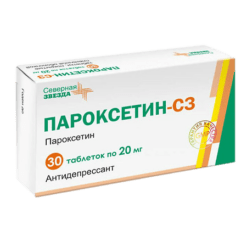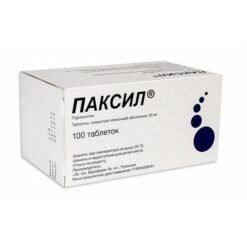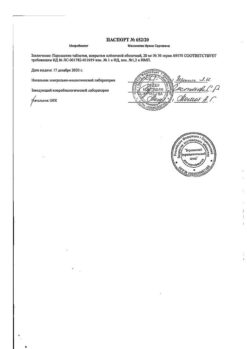No products in the cart.
Paroxetine, 20 mg 30 pcs
€1.00
Out of stock
(E-mail when Stock is available)
Description
Mechanism of Action
Paroxetine is a potent and selective inhibitor of 5- hydroxytryptamine (5-HT, serotonin) reuptake. Its antidepressant activity and effectiveness in treating obsessive-compulsive disorder (OCD) and panic disorder is generally believed to be due to specific inhibition of 5-NT reuptake in brain neurons.
Paroxetine differs chemically from tricyclic, tetracyclic and other known antidepressants.
Paroxetine is characterized by low affinity for muscarinic cholinergic receptors, and animal studies have shown that it has only weak anticholinergic properties.
In line with this selective action, paroxetine has been shown in in vitro studies to have little affinity for α -1, α -2 and β adrenoreceptors, as well as for dopamine (D2), 5-HT1-like, 5HT2 and histamine (H1) receptors, unlike tricyclic antidepressants. The absence of interaction with postsynaptic receptors in vitro is confirmed by the results of in vivo studies, which show that paroxetine does not inhibit the central nervous system (CNS) and does not cause arterial hypotension.
Pharmacodynamic properties
Paroxetine does not impair psychomotor functions and does not increase the CNS depressant effect of ethanol.
Like other selective 5-NT reuptake inhibitors, paroxetine causes symptoms of overstimulation of 5-NT receptors when administered to animals that have previously received monoamine oxidase inhibitors (MAOIs) or tryptophan.
In behavioral and EEG assessment studies, paroxetine has been shown to cause weak activating effects at doses greater than those required to inhibit 5-NT reuptake. Its activating properties are not “amphetamine-like” in nature.
In animal studies, good cardiovascular tolerance has been shown.
Paroxetine does not cause clinically significant changes in blood pressure, heart rate and ECG after use in healthy individuals.
Studies have shown that unlike antidepressants, which inhibit norepinephrine reuptake, paroxetine has much less ability to inhibit the antihypertensive effects of guanethidine.
Indications
Indications
Active ingredient
Active ingredient
Composition
Composition
How to take, the dosage
How to take, the dosage
The drug Paroxetine is recommended to be taken once a day in the morning with a meal. The tablets should be swallowed without chewing. The applied risk allows dividing the tablet in half, if necessary, to obtain a dose of 10 mg.
Interaction
Interaction
Serotonergic drugs
The use of paroxetine, as well as other drugs of the SSRI group, simultaneously with serotonergic drugs may cause effects associated with 5-NT receptors (serotonin syndrome). When concomitant use of serotonergic drugs (including L-tryptophan, tryptans, tramadol, SSRIs, fentanyl, lithium and St. John’s wort preparations) with paroxetine, care should be taken and clinical monitoring should be thoroughly conducted.
Simultaneous use of paroxetine with MAO inhibitors (including linezolid (an antibiotic that is a reversible non-selective MAO inhibitor) and methylthionine chloride (methylene blue) is contraindicated.
Pimozide
In a study of concomitant use of paroxetine and pimozide in a single low dose (2 mg), an increase in the concentration of pimozide was reported. This fact is explained by the known property of paroxetine to inhibit the CYP2D6 isoenzyme system. Due to the narrow therapeutic index of pimozide and its known ability to prolong the QT interval, concomitant use of pimozide and paroxetine is contraindicated.
Drug metabolizing enzymes
Metabolism and pharmacokinetics of paroxetine may be altered by the induction or inhibition of enzymes involved in drug metabolism.
When using paroxetine concomitantly with a known inhibitor of enzymes involved in drug metabolism, use of paroxetine at a dose that is at the lower end of the therapeutic dose range should be recommended.
The initial dose of paroxetine is not adjusted if it is used concomitantly with a drug that is a known inducer of enzymes involved in drug metabolism (e.g., carbamazepine, rifampicin, phenobarbital, phenytoin). Any subsequent dose adjustment of paroxetine should be determined by its clinical effect (tolerability and efficacy).
Fosamprenavir and ritonavir
The co-administration of fosamprenavir/ritonavir with paroxetine resulted in a significant decrease in plasma paroxetine concentrations. Plasma concentrations of fosamprenavir/ritonavir when concomitantly used with paroxetine were comparable to control values from other studies, indicating no significant effect of paroxetine on fosamprenavir/ritonavir metabolism. There are no data on the effects of long-term co-administration of paroxetine with fosamprenavir/ritonavir. Any dose adjustment of paroxetine should be determined by its clinical effect (tolerability and efficacy).
Procyclidine
Daily administration of paroxetine significantly increases plasma concentrations of procyclidine. If anticholinergic effects occur, the dose of procyclidine should be reduced.
Anticonvulsants
The concomitant use of paroxetine and anticonvulsants (carbamazepine, phenytoin, sodium valproate) does not affect their pharmacokinetic and pharmacodynamic profiles in patients with epilepsy.
Myorelaxants
The drugs of the group of selective serotonin reuptake inhibitors (SSRIs) may decrease plasma cholinesterase activity, which leads to an increase in the duration of neuromuscular blocking effects of mivacurium and suxamethonium.
Paroxetine’s ability to inhibit the CYP2D6 isoenzyme
Like other antidepressants, including other drugs in the SSRI group, paroxetine inhibits the hepatic CYP2D6 enzyme, which belongs to the cytochrome P450 system. Inhibition of CYP2D6 enzyme may lead to increased plasma concentrations of simultaneously used drugs that are metabolized by this enzyme. Such drugs include some tricyclic antidepressants (e.g., amitriptyline, nortriptyline, imipramine and desipramine), phenothiazine-type neuroleptics (perphenazine and thioridazine), risperidone, atomoxetine, some class 1c antiarrhythmic agents (such as propafenone and flecainide) and metoprolol. Paroxetine is not recommended in combination with metoprolol for heart failure, due to the narrow therapeutic index of metoprolol in this indication.
The irreversible inhibition of the CYP2D6 system by paroxetine may lead to decreased plasma concentrations of endoxifen and decreased effectiveness of tamoxifen.
CYP3A4
An in vivo study to evaluate the interaction when used concomitantly under equilibrium conditions of paroxetine and terfenadine, which is a substrate of CYP3A4 isoenzyme, showed that paroxetine has no effect on the pharmacokinetics of terfenadine. A similar in vivo interaction study found no effect of paroxetine on the pharmacokinetics of alprazolam, and vice versa. Concomitant use of paroxetine with terfenadine, alprazolam and other drugs that are substrates of CYP3A4 isoenzyme is not expected to have adverse effects on the patient.
Drugs affecting gastric pH
The absorption and pharmacokinetics of paroxetine have been shown to be independent or nearly independent in clinical studies (i.e. existing dependence does not require a change in dose) on:
Peroral anticoagulants
Perhaps a pharmacodynamic interaction between paroxetine and oral anticoagulants may occur. Concomitant use of paroxetine and oral anticoagulants may increase anticoagulant activity and risk of bleeding. Therefore, paroxetine should be used with caution in patients receiving oral anticoagulants.
Non-steroidal anti-inflammatory drugs (NSAIDs), acetylsalicylic acid and other antiplatelet agentsParoxetine and NSAIDs/acetylsalicylic acid may interact pharmacodynamically. Concomitant use of paroxetine and NSAIDs/acetylsalicylic acid may increase the risk of bleeding.
. Caution should be exercised when treating patients receiving SSRIs concomitantly with oral anticoagulants, with drugs that affect platelet function or increase the risk of bleeding (e.g., atypical neuroleptics such as clozapine, phenothiazines, most tricyclic antidepressants, acetylsalicylic acid, NSAIDs, cyclooxygenase-2 (COX-2) inhibitors), and when treating patients with a history of clotting disorders or conditions that may cause a predisposition to bleeding.
Special Instructions
Special Instructions
Children and adolescents (under 18 years of age)
The drug Paroxetine-SZ should not be used in children and adolescents under 18 years of age.
The treatment with antidepressants in children and adolescents with moderate to severe depressive episodes, recurrent depressive disorder and other mental illnesses is accompanied by an increased risk of suicidal ideation and suicidal behavior.
In clinical studies, adverse reactions associated with suicide attempts and suicidal ideation and hostility (primarily aggression, deviant behavior and anger) were observed more frequently in children and adolescents who received paroxetine than in patients in this age group who received placebo. There are currently no data on the long-term safety of paroxetine in children and adolescents that address the effects of the drug on growth, maturation, cognitive and behavioral development.
Clinical impairment and suicidal risk in adults
Young patients, especially those with moderate to severe depressive episodes and recurrent depressive disorder, may be at increased risk for suicidal behavior during paroxetine therapy. An analysis of placebo-controlled studies in adults with mental illness indicates an increased incidence of suicidal behavior in younger patients (prospectively defined age 18-24 years) on paroxetine compared to the placebo group: 17/776 (2.19%) versus 5/542 (0.92%), respectively, although the observed difference was not statistically significant. No increase in the frequency of suicidal behavior was observed in patients in older age groups (25 to 64 years and over 65 years).
In adults of all age groups with moderate to severe depressive episodes and recurrent depressive disorder, there was a statistically significant increase in suicidal behavior with paroxetine treatment compared to the placebo group (frequency of suicide attempts: 11/3455 (0.32%) versus 1/1978 (0.05%), respectively). However, the majority of these cases on paroxetine (8 of 11) were in young patients between the ages of 18 and 30. Data from a study involving patients with moderate to severe depressive episodes and recurrent depressive disorder may indicate an increased incidence of suicidal behavior in younger patients, which may persist in patients over 24 years of age with various psychiatric disorders.
In depressed patients, exacerbation of symptoms and/or the occurrence of suicidal ideation and suicidal behavior (suicidality) may occur regardless of receipt of antidepressants. This risk persists until significant remission is achieved. In general, clinical experience with all antidepressants shows that the risk of suicide may increase in the early stages of recovery.
Other psychiatric disorders for which paroxetine is indicated may also be associated with an increased risk of suicidal behavior, these disorders may also be combined with moderate to severe depressive episodes and recurrent depressive disorder. In addition, patients with a history of suicidal behavior or suicidal ideation, younger patients, and patients with significant suicidal ideation prior to treatment are at greatest risk for suicidal thoughts or attempts. All patients should be monitored for timely detection of clinical deterioration (including new symptoms) and suicidality throughout the course of treatment, especially at the beginning of treatment, or when the drug dose is changed (increased or decreased).
Patients (and their caregivers) should be warned to watch for deterioration (including the development of new symptoms) and/or the appearance of suicidal behavior or thoughts of self-harm. If these symptoms occur, medical attention should be sought immediately.
It must be remembered that symptoms such as agitation, akathisia or mania may be related to either the underlying illness or a consequence of the therapy used.
If symptoms of clinical deterioration (including the development of new symptoms) and/or suicidal ideation and/or suicidal behavior occur, particularly if they appear suddenly, if their severity increases, or if the symptoms were not part of a previous symptomology in this patient, the therapy should be reviewed until the drug is discontinued.
Akathisia
In rare cases, treatment with paroxetine or another SSRI product is accompanied by the development of akathisia, which is manifested by feelings of inner restlessness and psychomotor agitation when the patient cannot sit or stand quietly; the patient usually experiences subjective discomfort with akathisia.
The likelihood of akathisia is highest in the first few weeks of treatment.
Serotonin syndrome, malignant neuroleptic syndrome
In rare cases, serotonin syndrome or symptoms similar to malignant neuroleptic syndrome may develop during paroxetine treatment, particularly if paroxetine is used in combination with other serotonergic drugs and/or neuroleptics. These syndromes are potentially life-threatening, and therefore paroxetine treatment should be discontinued if they occur (they are characterized by groups of symptoms such as hyperthermia, muscle rigidity, myoclonus, autonomic disturbances with possible rapid changes in vital signs, mental status changes including confusion, irritability, extremely severe agitation, progressing to delirium and coma) and symptomatic maintenance therapy should be started. Paroxetine should not be used in combination with serotonin precursors (such as L-tryptophan and oxytriptan) due to the risk of serotoninergic syndrome.
Mania and bipolar disorder
A major depressive episode may be the initial manifestation of bipolar disorder. It is generally believed (although not proven by controlled clinical trials) that treatment of such an episode with an antidepressant alone may increase the likelihood of accelerated development of a mixed or manic episode in patients at risk for bipolar disorder. Before starting antidepressant treatment, a thorough screening should be performed to assess a patient’s risk for bipolar disorder; such a screening should include collecting a detailed psychiatric history, including family history of suicide, bipolar disorder, and depression.
It should be noted that paroxetine is not intended to treat a depressive episode within bipolar disorder. Like other antidepressants, paroxetine should be used with caution in patients with a history of mania.
Tamoxifen
It has been shown in some studies that the efficacy of tamoxifen, which has been assessed by risk of breast cancer recurrence and mortality, may be reduced when used together with paroxetine due to the irreversible inhibition of the CYP2D6 isoenzyme by paroxetine. The risk may increase with prolonged co-administration. When using tamoxifen to treat or prevent breast cancer, consider using alternative antidepressants that do not have an inhibitory effect on CYP2D6 isoenzyme or have this effect to a lesser degree.
Bone fractures
Epidemiological studies assessing the risk of bone fractures have found an association of bone fractures with taking certain antidepressants, including SSRIs. The risk was observed during the course of antidepressant treatment and was maximal at the beginning of therapy. The likelihood of bone fractures should be considered when using paroxetine.
Diabetes mellitus
In patients with diabetes mellitus, treatment with SSRIs may affect glycemic control. Adjustment of the dose of insulin and/or oral hypoglycemic drugs may be required.
IMAOs
Paroxetine treatment should be started with caution 2 weeks after stopping treatment with irreversible IMAOs or 24 hours after stopping treatment with reversible IMAOs. The dose of paroxetine should be increased gradually until optimal therapeutic effect is achieved.
Renal or hepatic impairment
Cautious use of paroxetine is recommended in patients with severe renal impairment or patients with hepatic impairment.
Epilepsy
Like other antidepressants, paroxetine should be used with caution in patients with epilepsy.
Convulsive seizures
The incidence of seizures in patients taking paroxetine is less than 0.1%. If a seizure occurs, treatment with paroxetine should be discontinued.
Electroconvulsive therapy
There is only limited experience with concomitant use of paroxetine and electroconvulsive therapy.
Glaucoma
Like other drugs in the SSRI group, paroxetine may cause mydriasis and should be used with caution in patients with closed-angle glaucoma.
Hyponatremia
In treatment with paroxetine, hyponatremia is rare, occurs mostly in elderly patients, and levels off after paroxetine withdrawal.
Bleeding
Bleeding of the skin and mucous membranes (including gastrointestinal and gynecological bleeding) has been reported in patients while taking paroxetine. Therefore, paroxetine should be used with caution in patients who simultaneously receive drugs that increase the risk of bleeding, in patients with a known propensity for bleeding and in patients with diseases that predispose to bleeding.
Heart diseases
The usual precautions should be observed when treating patients with heart disease.
Symptoms observed when discontinuing treatment with paroxetine in adults
According to the results of clinical studies in adults, the incidence of adverse reactions when discontinuing treatment in patients taking paroxetine was 30%, whereas the incidence of adverse reactions in the placebo group was 20%. Withdrawal symptoms did not imply addiction or dependence, as with substances of abuse.
The withdrawal symptoms described include dizziness, sensory disturbances (including paresthesias, electric shocks and tinnitus), sleep disturbances (including vivid dreams), agitation or anxiety, nausea, tremors, confusion, increased sweating, headaches and diarrhea, palpitations, emotional lability, irritability and visual disturbances. These symptoms are usually mild to moderate, but may be severe in some patients. These symptoms are usually mild to moderate, but in some patients they may be severe.
Symptoms usually develop in the first few days after withdrawal of the drug, but in very rare cases occur in patients who have accidentally missed a dose. These symptoms usually go away spontaneously and disappear within 2 weeks, but some patients may have symptoms for much longer (2-3 months or more). It is recommended that the dose of paroxetine be reduced gradually over several weeks or months before withdrawing it completely, depending on the needs of the individual patient.
Symptoms that may occur when discontinuing paroxetine treatment in children and adolescents.
In clinical studies in children and adolescents, the incidence of adverse reactions when paroxetine is discontinued was 32%, whereas the incidence of adverse reactions in the placebo group was 24%. After paroxetine withdrawal, the following adverse reactions were reported in at least 2% of patients and occurred at least twice as often as in the placebo group: emotional lability (including suicidal thoughts, suicide attempts, mood changes and tearfulness), nervousness, dizziness, nausea and abdominal pain.
The clinical experience with paroxetine indicates that it does not impair cognitive and psychomotor functions. However, as with any other psychotropic medication, patients should be especially careful when driving or operating machinery.
Although paroxetine does not increase the negative effects of alcohol on psychomotor functions, it is not recommended to use paroxetine and alcohol simultaneously.
Contraindications
Contraindications
Side effects
Side effects
The frequency and intensity of some of the paroxetine adverse reactions listed below may decrease as treatment continues, and such reactions usually do not require withdrawal of the drug. The adverse reactions presented below are listed according to organ system involvement and frequency of occurrence.
The incidence is defined as follows: very common (â¥1/10), common (â¥1/100, <1/10), infrequent (â¥1/1000, <1/100), rare (â¥1/10000, <1/1000), very rare (<1/10000), including individual cases, and frequency unknown.
The incidence of frequent and infrequent adverse reactions was determined based on summarized safety data of the drug in more than 8,000 patients participating in clinical trials, calculated from the difference between the incidence of adverse reactions in the paroxetine group and in the placebo group.
The incidence of rare and very rare adverse reactions was determined based on post-marketing data, and this rate reflects the frequency of reported reactions more than the true incidence of reactions.
Disorders of the blood and lymphatic system:
infrequent – pathological bleeding, mainly bleeding of the skin and mucous membranes (including ecchymosis);
very rare – thrombocytopenia.
Immune system disorders:
very rarely – severe allergic reactions (including anaphylactoid reactions and angioedema).
Endocrine system disorders:
very rare – syndrome of inadequate secretion of antidiuretic hormone.
Metabolic and nutrition disorders:
often – decreased appetite, increased cholesterol concentration;
rarely – hyponatremia. Hyponatremia occurs mainly in elderly patients and in some cases is caused by inadequate secretion of antidiuretic hormone.
Psychiatric disorders:
often – somnolence, insomnia, agitation, abnormal dreams (including nightmares);
infrequently – confusion, hallucinations;
rarely – manic reactions, anxiety, depersonalization, panic attacks, akathisia;
frequency unknown – suicidal thoughts and suicidal behavior.
Cases of suicidal ideation and suicidal behavior have been reported during paroxetine treatment or early after discontinuation of treatment. These symptoms may be due to an underlying medical condition.
Nervous system disorders:
often – dizziness, tremor, headache, impaired concentration;
infrequently – extrapyramidal disorders;
rarely – seizures, restless legs syndrome;
very rarely – serotonin syndrome (symptoms may include agitation, confusion, increased sweating, hallucinations, hyperreflexia, myoclonus, tachycardia with tremors and tremors).
The development of extrapyramidal symptoms, including orofacial dystonia, has sometimes been observed in patients with impaired motor function or who have used neuroleptics.
Visual disorders:
often – blurred vision;
infrequently – mydriasis;
very rarely – acute glaucoma.
Hearing and balance disorders:
frequency unknown – tinnitus.
Cardiovascular system disorders:
infrequent – sinus tachycardia, postural hypotension, temporary increase and decrease of blood pressure.
Temporary increase and decrease of blood pressure have been reported after paroxetine treatment, usually in patients with previous hypertension or anxiety;
rarely – bradycardia.
Respiratory, chest and mediastinal disorders:
often – yawning.
Gastrointestinal disorders:
very common – nausea;
frequent – constipation, diarrhea, vomiting, dry mouth;
very rare – gastrointestinal bleeding.
Hepatic and biliary tract disorders:
rare – increased liver enzyme activity;
very rare – adverse reactions on the liver (such as hepatitis, sometimes accompanied by jaundice and/or liver failure). Increased liver enzymes activity has been reported.
Post-registration reports of adverse reactions on the liver (such as hepatitis, sometimes accompanied by jaundice and/or liver failure) were very rare. The appropriateness of discontinuing treatment with paroxetine should be considered in cases of prolonged increase in liver function tests.
Skin and subcutaneous tissue disorders:
frequently – increased sweating,
infrequently – skin rash, itching;
very rarely – photosensitivity reactions, severe skin reactions (including erythema multiforme, Stevens-Johnson syndrome and toxic epidermal necrolysis), urticaria.
Renal and urinary tract disorders:
infrequently – urinary retention, urinary incontinence.
Gender and mammary gland disorders:
very common – sexual dysfunction;
rarely – hyperprolactinemia, galactorrhea, menstrual cycle disorders (including menorrhagia, metrorrhagia and amenorrhea);
very rare – priapism.
Musculoskeletal system disorders:
rarely – arthralgia, myalgia.
Epidemiological studies, conducted primarily with patients aged 50 years and older, have shown an increased risk of bone fractures in patients receiving SSRIs and tricyclic antidepressants. The mechanism underlying this risk is unknown.
General disorders and disorders at the site of administration:
often, asthenia, weight gain;
very rarely, peripheral edema.
Symptoms occurring upon discontinuation of paroxetine treatment:
often – dizziness, sensory disturbances, sleep disturbances, anxiety, headache;
infrequently – agitation, nausea, tremor, confusion, increased sweating, emotional lability, visual disturbances, palpitations, diarrhea, irritability.
. As with withdrawal of other psychotropic medications, discontinuation of paroxetine treatment (especially abruptly) may cause symptoms such as dizziness, sensory disturbances (including paresthesias, electrical shocks and tinnitus), sleep disturbances (including vivid dreams), agitation or anxiety, nausea, headache, tremors, confusion, diarrhea, increased sweating, palpitations, emotional lability, irritability, visual disturbances. In most patients, these symptoms are mild to moderate and resolve spontaneously. No patient group is known to be at increased risk for these symptoms; therefore, if paroxetine treatment is no longer necessary, its dose should be reduced slowly until the drug is completely discontinued.
The following adverse reactions have been observed in clinical trials involving children: Emotional lability (including self-harm, suicidal ideation, suicide attempts, tearfulness, and mood swings), bleeding, hostility, decreased appetite, tremors, increased sweating, hyperkinesia, and agitation. Suicidal ideation and suicide attempts were mostly observed in clinical trials involving adolescents with moderate to severe depressive episodes and recurrent depressive disorder. Hostility has been observed particularly in children with obsessive-compulsive disorder, especially those younger than 12 years of age.
. In clinical studies, when the daily dose was gradually reduced (the daily dose was reduced by 10 mg per day at one-week intervals to a dose of 10 mg per day for one week), symptoms such as emotional lability, nervousness, dizziness, nausea, and abdominal pain were observed in at least 2% of patients when the paroxetine dose was reduced or after complete drug withdrawal and occurred at least 2 times as often as in the placebo group.
Overdose
Overdose
Symptoms
The available information on paroxetine overdose suggests a wide range of safety.
In paroxetine overdose, fever, changes in blood pressure, involuntary muscle contractions, anxiety, and tachycardia have been observed in addition to the symptoms described in the side effects section. Patients usually normalized without serious consequences, even with single doses of up to 2000 mg. A number of reports described symptoms such as coma and ECG changes, cases of lethal outcome were very rarely observed, usually reported in situations where patients took paroxetine with or without other psychotropic drugs with or without alcohol.
Treatment
The specific antidote for paroxetine is not known. Treatment should include the general measures used for overdose with any antidepressants. Supportive therapy and frequent monitoring of basic physiological parameters, as well as close monitoring are indicated. The patient should be treated according to the clinical picture or in accordance with the recommendations of the national poison center, if available.
Similarities
Similarities
Additional information
| Conditions of storage | In the dark place at a temperature not exceeding 25 ° C. Keep out of reach of children. |
|---|---|
| Manufacturer | Moscow Endocrine Plant, Russia |
| Medication form | pills |
| Brand | Moscow Endocrine Plant |
Other forms…
Related products
Buy Paroxetine, 20 mg 30 pcs with delivery to USA, UK, Europe and over 120 other countries.





















